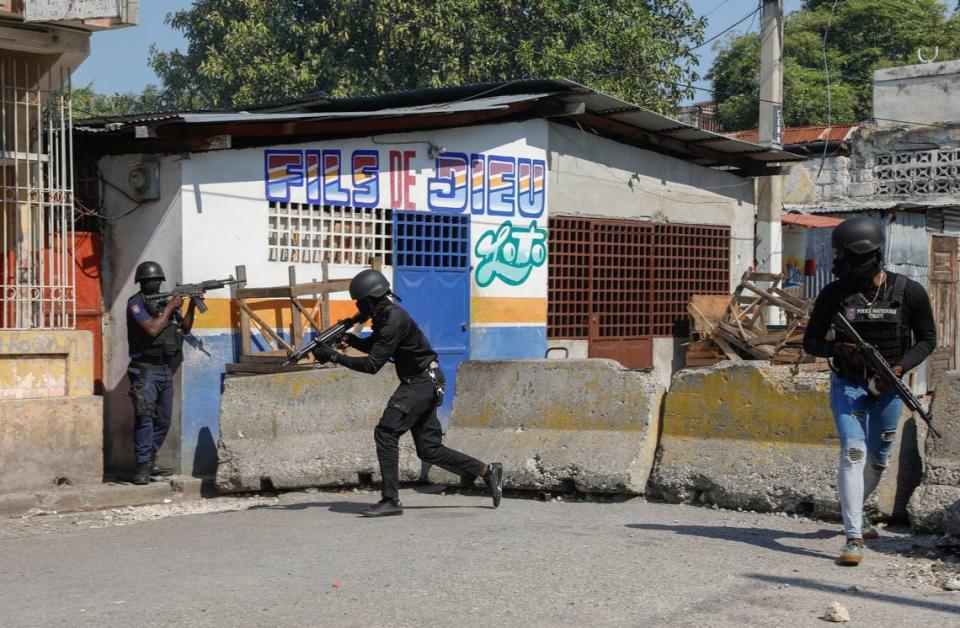Haiti’s National Penitentiary, already the target of mass prison break by gangs, catches fire
First, armed groups attacked Haiti’s largest prison and orchestrated a jailbreak of nearly 4,000 inmates, many of them murderers, kidnappers and gang leaders.
Now the country’s National Penitentiary is on fire.
The flames from inside the mammoth structure sent up billows of black smoke across Port-au-Prince’s skies on Thursday, as bursts of automatic gunfire could be heard in the capital again after a few days of relative calm. The prison was empty after the few prisoners who did not escape on March 2 and 3 were relocated. So far, the fire appears to be accidental, several sources told the Miami Herald. A spokesperson for the Haiti National Police was not immediately available.
As a fire brigade made its way to the structure, Haitian police across town were once more fighting off a gang attack. Armed groups, which have been attempting to take control of the international and domestic airports, made their way to the perimeter and opened fire across the runway. On the other side: the headquarters of the Haiti National Police. A Haitian police official inside the headquarters confirmed the incident and said police successfully battled the gangs back. There are unconfirmed reports that at least one person, a former head of the specialized border police unit, was wounded in the incident.
Later in the afternoon, the home of Haiti National Police Director Frantz Elbé, located in the Santo neighborhood of Croix-des-Bouquets, also went up in flames. Elbe didn’t respond to a request for comment but the fire was confirmed by several sources, who did not know if he was targeted. The streets of the capital, normally teeming with foot traffic and cars, were quiet as people remained at home and banks shut their doors at noon.
Le Pénitencier National est actuellement en feu. L'information est confirmée par des responsables de l'APENA. L'origine de l'incendie demeure pour l'heure inconnu. Depuis l'attaque armée des bandits contre le plus grand centre carcéral du pays, il n'y avait plus aucun détenu. pic.twitter.com/cMqML7oklZ
— Gazette Haiti (@GazetteHaiti) March 14, 2024
Marie Yolene Gilles, a human-rights activist with Eyes Wide Open/La Fondasyon Je Klere who monitors Haiti’s prison system, said that the fire at the prison appears to have started in the high-security part of the prison that inmates call “the Titanic.” The top level is where kidnappers and other major criminals are housed, while at the bottom is an isolation area that was temporarily used to hold 17 Colombians recently indicted in the July 2021 assassination of Haitian President Jovenel Moïse.
The Colombians were quietly moved out the day after armed groups, with the aide of a drone, attacked the prison and freed more close to 4,000 prisoners. Among those who were freed were several high-profile gang leaders and two former top police officials who were in charge of Moïse’s presidential detail, Dimitri Hérard and Jean Laguel Civil. They were also charged in the murder along with dozens of others by an investigative judge in Haiti.
Prior to the recent coordinated violent attacks threatening to topple what’s left of the Haitian state, the United Nations office in Port-au-Prince was reviewing Haiti’s prisons to determine where detained gang members may be held after the arrival of a Multinational Security Support mission led by Kenya. There were few options, given that most of the prisons are overcrowded with inmates who have been detained for years without ever being seen by a judge or formally charged.
One facility, a newly U.S. built women’s prison located on the outskirts of Port-au-Prince in the town of Cabaret, was already overtaken by gangs in late January, after authorities were forced to move out inmates when repeated gang attacks led to a mass prison break. A second, in the suburbs of Croix-des-Bouquets, was also attacked by gangs the same day they breached the National Penitentiary.
In its latest report, the Eyes Wide Open Foundation said there 1,030 prisoners at the Croix-des-Bouquets prison when it came under attack, and 3,696 inside the National Penitentiary. The area of the Titanic, which is believed to be where the fire started, had the padlocks of the cells broken by gang members, who then went one-by-one to free their respective leaders.
Of those the detainees at the National Penitentiary, only 87 responded to prison officials’ call to return on the next day around noon. Some 3,609 remain free, among them dangerous criminals, kidnappers, rapists and terrorists, the report said.
The report notes that the mass prison break was premeditated and was announced ahead of time on Feb. 29, when gang leaders published excerpts from a meeting where they decided to do everything in their power to free the inmates at the prison in Port-au-Prince before attacking other targets such as the National Palace.
“They announced their strategy: attack at several points at the same time to keep the police busy and make it impossible for the [Haiti National Police] to respond to all these fronts at the same time,” the report said. “The same day, they went from speaking to actions: bursts of automatic weapons are heard a little everywhere, public offices, churches, police stations and even hospitals are attacked.”
As of late Wednesday, five groups had submitted names to the 15-member Caribbean Community regional bloc, known as CARICOM, to sit on a presidential panel charged with leading Haiti’s transition and helping the country find a way out of the crisis.
On Thursday, the United Nations continued its call for Haiti’s political and civic society to quickly decide who will make up that transitional panel with seven voting members and two non-voting members.
“The process needs to be Haitian led; Haitian political class, Haitian civil society, Haitian stakeholders need to find the best solution and the best way forward and there is a plan that has been laid out,” said Stéphane Dujarric, spokesman for U.N. Secretary-General António Guterres.



